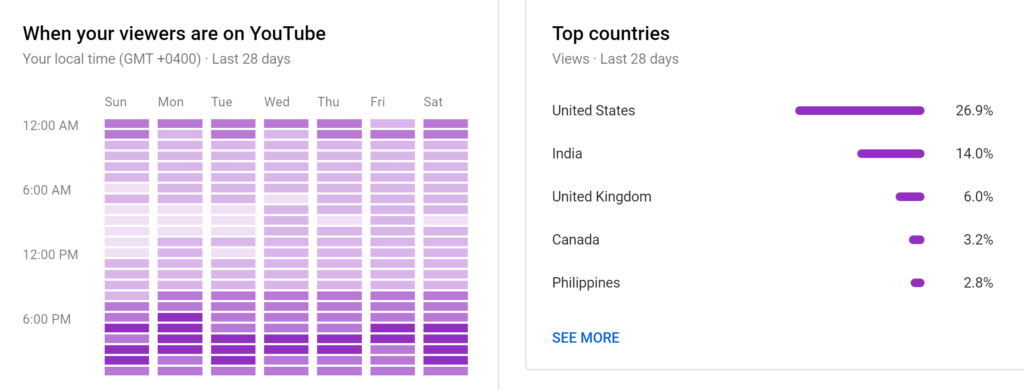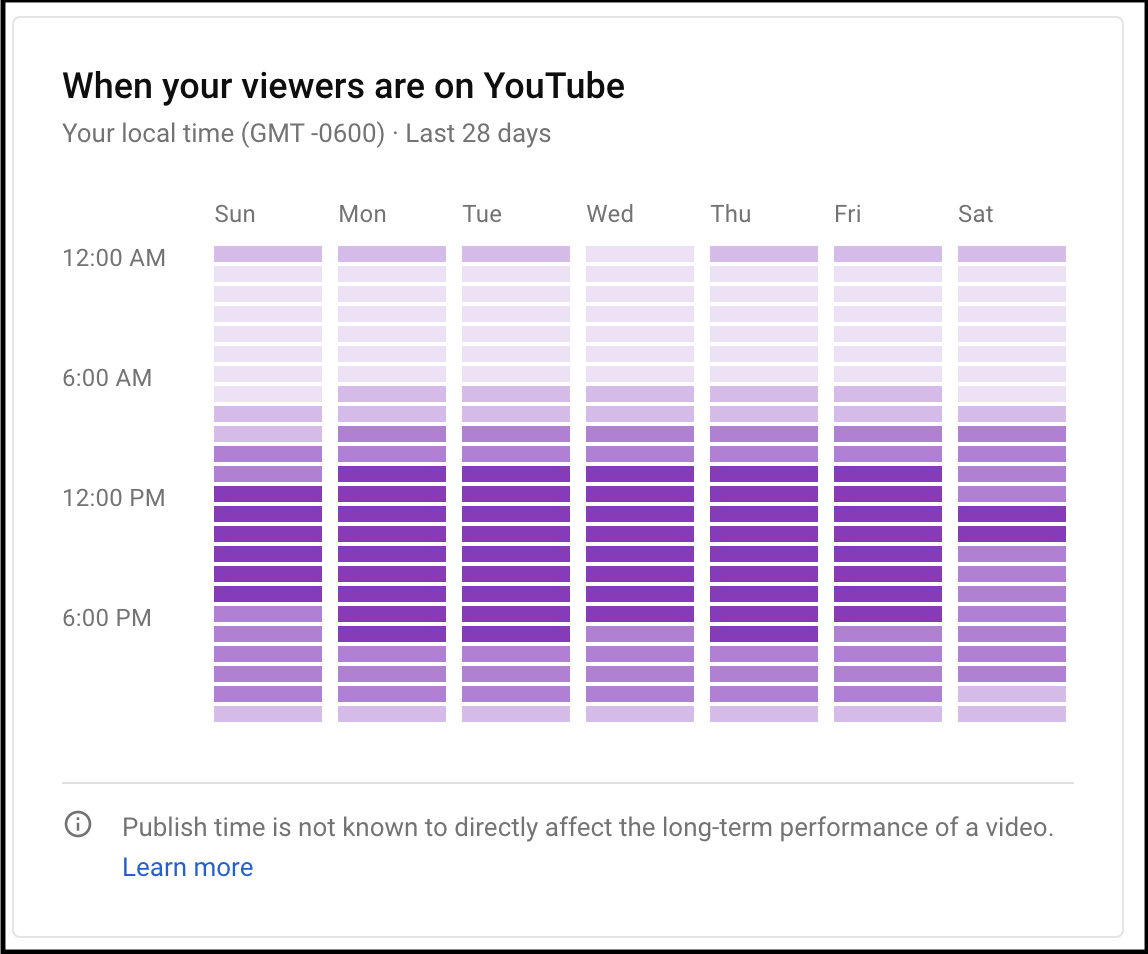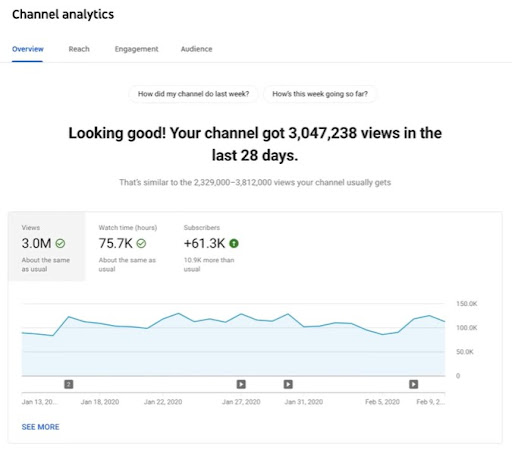Welcome to the vibrant world of YouTube! As a content creator, knowing who’s watching your videos is vital for tailoring your content and engaging with your audience effectively. Understanding your viewers helps you create videos that resonate with them, increasing both your views and subscriber count. In this post, we’ll explore how to check your viewers' age and why it’s important for your channel's growth. Let’s dive into the basics of audience insights!
Why Knowing Your Viewers' Age Matters

Knowing your viewers' age can significantly impact your content strategy. Here's why it matters:
- Content Relevance: By understanding the age demographics, you can create content that speaks directly to your audience. For instance, if your viewers are mostly teenagers, a different tone and style might be appropriate compared to a channel with an older audience.
- Targeted Marketing: If you're monetizing your channel or working with brands, knowing your audience's age helps in attracting advertisers who wish to reach a specific age group. Age demographics can inform the types of brands that are interested in collaborating with you.
- Engagement Strategies: The way different age groups interact with content varies. Younger audiences may prefer fast-paced, visually stimulating videos, while older viewers might appreciate longer, in-depth discussions. Knowing their age helps you optimize your engagement strategies.
- Future Growth: Understanding your audience’s age allows you to anticipate shifts in viewership. If your channel is gaining popularity among a younger demographic, you can pivot your content as needed to keep up with trends.
- Analytics and Performance: Insights into age demographics contribute to a better understanding of your overall performance. It enables you to tailor your titles, thumbnails, and video descriptions to attract certain age groups, optimizing click-through rates.
Additionally, considering viewers' age influences your approach to community building. For example, engaging younger viewers through interactive content, like polls or challenges, can foster a more active community. On the other hand, a mature audience may prefer discussions or expert interviews that provide value and insights.
In summary, knowing your viewers' age isn't just a trivial statistic; it’s a powerful tool that can shape your content strategy. It allows you to connect on a deeper level and gives you the opportunity to adapt your message effectively. Keep reading to discover how to find this valuable information and leverage it for your channel's success!
Also Read This: How to Delete Watched Recordings from Your YouTube TV Library
3. How to Access YouTube Analytics

Accessing YouTube Analytics is your first step to understanding your audience better. If you're serious about improving your content and engaging with your viewers, diving into the analytics is a must. Don’t worry; it’s super easy to get there!
First, make sure you’re logged into your YouTube account. Once you're in, follow these simple steps:
- Click on your profile picture located at the top right corner of the screen.
- Select YouTube Studio from the drop-down menu.
- On the left sidebar, look for the Analytics option and click on it.
And just like that, you’re in! YouTube Analytics gives you a treasure trove of data about your channel and videos. But wait, there’s more! You’ll find different tabs that break down your analytics into manageable sections:
- Overview: Get a high-level view of your channel's performance, including views, watch time, and subscribers.
- Reach: Learn how viewers discover your content, including impressions and click-through rates.
- Engagement: This part focuses on how long people are watching your videos, giving insights into viewer retention.
- Audience: Here’s where you’ll find demographic information, including age, gender, and location.
Spending some time in the Analytics section can be incredibly rewarding. You might stumble upon patterns you weren’t aware of—like which videos are attracting a younger audience or which are popular among older viewers. This will help shape the content you create moving forward!
Also Read This: Do Hashtags Work on YouTube Shorts? Optimizing Your Content for Better Visibility
4. Finding the Age Demographics of Your Viewers

Now that you've accessed YouTube Analytics, it's time to get into the juicy details—specifically, the age demographics of your viewers. Knowing the age range of your audience can significantly influence your content strategy.
To find this information, remain in the Audience tab of YouTube Analytics. Here’s a detailed breakdown of what you’ll see and how to interpret the data:
- Scroll down to the Top Geographies section. It provides a quick insight into where your viewers are coming from.
- Look for the Age and Gender section. Here, you'll see a pie chart or bar graph representing various age groups that watch your videos.
The age groups are typically segmented in this way:
- 18-24
- 25-34
- 35-44
- 45-54
- 55-64
- 65+
Now, what do these numbers mean for you? Let’s say you notice a significant number of viewers in the 18-24 age range but very few in the older demographics. This insight could lead you to tailor your content to be more appealing to that younger audience—perhaps by introducing trending topics, memes, or references they resonate with.
On the other hand, if you find a diverse age group, consider producing varied content that can cater to multiple segments. For example, you might create tutorials that appeal to older viewers while also offering fun, engaging content for the younger crowd.
In short, understanding your viewers' age demographics not only helps you create better content but also builds stronger connections with your audience. Don’t be afraid to experiment based on what you learn—your content's potential is limitless!
Also Read This: How to Delete Shows from Your Library on YouTube TV
5. Interpreting Age Data: What It Means for Your Content
So, you’ve gathered some age data about your YouTube viewers. Awesome! But what does all of this mean for your content? Understanding the age demographics of your audience is like having a treasure map; it helps you navigate your content creation more effectively.
First off, let’s talk about the significance of age. Different age groups have distinct preferences and interests. For example, younger viewers (ages 13-24) often gravitate towards trends, memes, and fast-paced content, while older viewers (ages 35 and above) may prefer in-depth discussions or tutorials. By interpreting this data, you can gain insights into what resonates with your audience.
Here are a few key points to consider:
- Content Relevance: Are your current topics appealing to the majority of your viewers' age range? If your most active viewers are teens, perhaps it’s time to sprinkle in more youthful and trendy subjects.
- Engagement Styles: Younger demographics often engage through comments and social media shares, whereas older viewers might prefer lurking. Tailoring your engagement strategies can improve interaction.
- Visual Aesthetics: The design and production style of your videos can resonate differently across age groups. A polished, professional look might appeal more to older viewers, whereas vibrant and quirky styles could attract younger audiences.
Lastly, remember that age is just one piece of the puzzle. Combine it with other analytics—like watch time and engagement rates—to paint a fuller picture of your audience’s preferences. This comprehensive understanding will empower you to create content that not only attracts viewers but also keeps them coming back for more!
Also Read This: How to Stop YouTube Ads on Your iPhone with Simple Steps
6. Strategies for Tailoring Content to Different Age Groups
Now that you know how to interpret the age data of your viewers, let’s dive into some actionable strategies for tailoring your content. Creating audience-specific content is key to fostering a loyal community. Whether you’re reaching Gen Z, Millennials, Gen X, or Baby Boomers, here’s how you can appeal to them:
1. Customize Topics and Themes
Focus on themes that resonate with different ages:
- Gen Z: Talk about mental health, social justice, and lifestyle tips. Content like "Day in the Life of a College Student" can be captivating.
- Millennials: Incorporate finance tips, travel vlogs, and nostalgic content reminiscent of their childhoods.
- Gen X and Baby Boomers: Create content revolving around life skills, technology tutorials (think how-to guides), and family-oriented discussions.
2. Adjust Your Tone and Language
Your language and tone should match your audience’s familiarity:
- For younger audiences, feel free to use slang, humor, and informal language to create a relatable vibe.
- With older viewers, a professional and informative tone may be more appropriate, showcasing credibility while still being engaging.
3. Choose the Right Format
Different ages prefer different video formats:
- Short-form content: Quick TikTok-style videos can engage a younger audience.
- Longer, in-depth videos: Tutorials and discussions work well for older viewers who appreciate detailed content.
In a nutshell, understanding the age demographics of your viewers provides a fantastic opportunity to refine your content strategy. Tailoring your approach not only meets your audience’s expectations but also enhances their viewing experience, fostering a loyal following on your channel.
Also Read This: How to Analyze a YouTube Competitor: Boosting Your Channel’s Strategy
7. Tools and Resources for Analyzing Your Audience
Understanding your YouTube audience goes beyond just tracking views and likes. To truly enhance your channel and cater to your viewers, it's crucial to leverage the right tools and resources tailored for deep analysis. Here are some must-have tools to get you started:
- YouTube Analytics: This is your primary tool. Within YouTube Studio, you can find detailed demographics about your viewers, including age, gender, location, and more. It’s like looking at a treasure map of who’s watching your content!
- Social Blade: This website provides a wealth of data and statistics about YouTube channels. You can track your channel’s growth and the demographics of your audience, offering a broader context for understanding viewer engagement.
- TubeBuddy: This browser extension is loaded with features that assist in optimizing your channel. TubeBuddy includes audience analytic tools that can help reveal who’s engaging with your content most.
- VidIQ: Similar to TubeBuddy, VidIQ helps with SEO but also offers audience insights. Its dashboard can show you how your videos perform across demographics, helping you understand what content resonates best.
- Google Trends: By checking out what’s trending in your niche, you can align your content more closely with what your potential audience is searching for. While not specifically for demographics, it gives you insight into general viewer interests.
By integrating these tools into your content creation process, you’ll have a clearer picture of who your audience is. This knowledge not only helps you craft content that appeals to your current viewers but also attracts new subscribers who might be interested in what you have to offer.
Remember, the key to growing your channel lies in understanding your audience. With the right tools, you can analyze and adapt your content strategy effectively, ensuring you continuously engage and expand your viewer base.
8. Conclusion: Enhancing Your YouTube Channel with Audience Insights
In the world of YouTube, knowing your audience is like holding the winning ticket in a lottery. The insights you can gather about your viewers' age, preferences, and engagement patterns are invaluable for shaping your channel's future. By leveraging tools like YouTube Analytics, Social Blade, and more, you empower yourself to fine-tune your content strategy.
Here's what you can take away:
- Personalization is Key: Tailoring your content to match the interests and age demographics of your viewers will keep them engaged and coming back for more. Think about what your audience wants!
- Experiment and Evolve: Use the insights gathered to test different types of content. For instance, if you notice younger audiences engage more with a certain theme, consider creating more of that type of content!
- Engage with Your Audience: Don’t hesitate to ask your viewers for feedback. Simple polls or question prompts can provide valuable insights while making your audience feel involved.
Ultimately, enhancing your YouTube channel with audience insights isn’t just about metrics but building a community. When you understand your viewers, you foster a loyal following that will champion your content. So, take the plunge, explore those tools, analyze your data, and watch as your channel transforms!
 admin
admin








